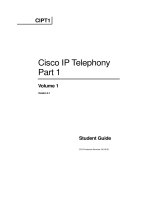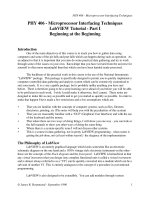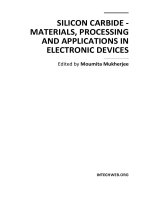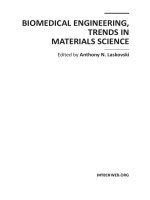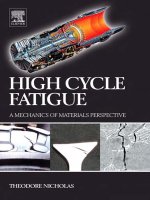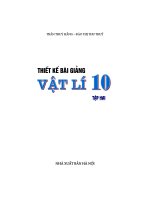Volume 10 - Materials Characterization Part 1 doc
Bạn đang xem bản rút gọn của tài liệu. Xem và tải ngay bản đầy đủ của tài liệu tại đây (1.02 MB, 90 trang )
ASM
INTERNATIONAL ®
Publication Information and Contributors
Materials Characterization was published in 1986 as Volume 10 of the 9th Edition Metals Handbook. With the third
printing (1992), the series title was changed to ASM Handbook. The Volume was prepared under the direction of the
ASM Handbook Committee.
Volume Coordinator
The Volume Coordinator was Ruth E. Whan, Sandia National Laboratories.
Organizing Committee
• Rafael Menezes Nunes UFRGS
• Ruth E. Whan Chairman Sandia National Laboratories
• Ray W. Carpenter Arizona State University
• Paul T. Cunningham Los Alamos National Laboratory
• William H. Dingledein Carpenter Technology Corporation
• Kenneth H. Eckelmeyer Sandia National Laboratories
• Dean A. Flinchbaugh Bethlehem Steel Corporation
• Raymond P. Goehner Siemens Corporation
• J.I. Goldstein Lehigh University
• Merton Herrington Special Metals
• Harris L. Marcus University of Texas
• Carolyn McCrory-Joy AT&T Bell Laboratories
• David A. Smith IBM Thomas J. Watson Research Center
• Suzanne H. Weissman Sandia National Laboratories
Authors and Reviewers
• Brent L. Adams Brigham Young University
• R.W. Armstrong University of Maryland
• Mark A. Arnold University of Iowa
• Roger A. Assink Sandia National Laboratories
• Raghavan Ayer Exxon Research & Engineering Company
• Delbert S. Berth University of Nevada
• Larry H. Bennett National Bureau of Standards
• S.M. Bhagat University of Maryland
• J.C. Bilello State University of New York at Stony Brook
• Jack Blakely Cornell University
• George A. Blann Buehler Ltd.
• G. Dana Brabson University of New Mexico
• S.S. Brenner University of Pittsburgh
• Chris W. Brown University of Rhode Island
• Elliot L. Brown Colorado School of Mines
• D.R. Browning Consultant
• Richard R. Buck University of North Carolina
• Robert W. Buennecke Caterpillar Tractor Company
• Merle E. Bunker Los Alamos National Laboratory
• Frank B. Burns Sandia National Laboratories
• Thomas A. Cahill University of California Davis
• Alan Campion University of Texas Austin
• Martin J. Carr Sandia National Laboratories
• Joel A. Carter Oak Ridge National Laboratory
• Anders Cedergren University Umea
• M.B. Chamberlain Sandia National Laboratories
• W.F. Chambers Sandia National Laboratories
• K.L. Cheng University of Missouri Kansas City
• Gary D. Christian University of Washington
• Wei-Kan Chu University of North Carolina
• M.J. Cieslack Sandia National Laboratories
• William A.T. Clark Ohio State University
• Stephen P. Clough Perkin-Elmer Corporation
• Dick Crawford Lawrence Livermore National Laboratory
• Nelda A. Creager Sandia National Laboratories
• Stanley R. Crouch Michigan State University
• D.R. Crow The Polytechnic, Wolverhampton
• A.W. Czanderna Solar Energy Research Institute
• P. D'Antonio Naval Research Laboratory
• David L. Davidson Southwest Research Institute
• Barry Diamondstone National Bureau of Standards
• David L. Donahue Oak Ridge National Laboratory
• Elsie M. Donaldson Canmet
• Thomas R. Dulski Carpenter Technology Corporation
• James R. Durig University of South Carolina
• Gareth R. Eaton University of Denver
• Kenneth H. Eckelmeyer Sandia National Laboratories
• T. Egami University of Pennsylvania
• Robert Ellefson Monsanto Research Corporation
• Loren Essig Leco Corporation
• Deon G. Ettinger Argonne National Laboratories
• Lynda M. Faires Los Alamos National Laboratory
• Horatio A. Farach University of South Carolina
• Paul B. Farnsworth Brigham Young University
• B. Fleet Imperial College
• D.M. Follstaedt Sandia National Laboratories
• Ronald L. Foster Allied Bendix Corporation
• James C. Franklin Oak Ridge Y-12 Plant
• Wolfgang Frech University of Umea
• R.B. Fricioni Leco Corporation
• William G. Fricke, Jr. Alcoa Technical Center
• Stephen W. Gaarenstroom General Motors Research Laboratory
• Mary F. Garbauskas General Electric R&D
• S.R. Garcia Los Alamos National Laboratory
• Anthony J. Garrett-Reed Massachusetts Institute of Technology
• John V. Gilfrich Naval Research Laboratory
• Ernest S. Gladney Los Alamos National Laboratory
• Raymond P. Goehner Siemens Corporation
• J.I. Goldstein Lehigh University
• Michael Gonzales Sandia National Laboratories
• John T. Grant University of Dayton Research Institute
• Robert B. Greegor The Boeing Company
• Q.G. Grindstaff Oak Ridge Y-12 Plant
• Anita L. Guy University of Arizona
• D.M. Haaland Sandia National Laboratories
• Richard L. Harlow E.I. DuPont de Nemours
• Jackson E. Harrar Lawrence Livermore National Laboratory
• W.W. Harrison University of Virginia
• Fred M. Hawkridge, Jr. Virginia Commonwealth University
• T.J. Headley Sandia National Laboratories
• G. Heath University of Edinburgh
• Kurt F.J. Heinrich National Bureau of Standards
• Michael B. Hintz Michigan Technological University
• Paul F. Hlava Sandia National Laboratories
• Paul Ho IBM Thomas J. Watson Research Center
• David H. Huskisson Sandia National Laboratories
• Hatsuo Ishada Case Western Reserve University
• Michael R. James Rockwell International Science Center
• A. Joshi Lockheed Palo Alto Research Laboratory
• Silve Kallmann Ledoux and Company
• J. Karle Naval Research Laboratory
• Michael J. Kelly Sandia National Laboratories
• Lowell D. Kispert University of Alabama
• David B. Knorr Olin Corporation
• John H. Konnert Naval Research Laboratory
• Jiri Koryta Czechoslovak Academy of Sciences
• Byron Kratochvil University of Alberta
• Aaron D. Krawitz University of Missouri Columbia
• G.R. Lachance Geological Survey of Canada
• Max G. Lagally University of Wisconsin
• D.G. LeGrand General Electric Company
• Donald E. Leyden Colorado State University
• Eric Lifshin General Electric R&D Center
• J.S. Lin Oak Ridge National Laboratory
• MacIntyre R. Louthan, Jr. Virginia Polytechnic Institute and State University
• Jesse B. Lumsden Rockwell International Science Center
• C.E. Lyman Lehigh University
• Curtis Marcott The Proctor & Gamble Company
• J.L. Marshall Oak Ridge Y-12 Plant
• George M. Matlack Los Alamos National Laboratory
• James W. Mayer Cornell University
• M.E. McAllaster Sandia National Laboratories
• Gregory J. McCarthy North Dakota State University
• Linda B. McGown Oklahoma State University
• N.S. McIntyre University of Western Ontario
• T. Mehrhoff General Electric Neutron Devices
• D.M. Mehs Fort Lewis College
• Louis Meites George Mason University
• C.A. Melendres Argonne National Laboratory
• Raymond M. Merrill Sandia National Laboratories
• M.E. Meyerhoff University of Michigan
• J.R. Michael Bethlehem Steel Corporation
• A.C. Miller Alcoa Technical Center
• Dennis Mills Cornell University
• M.M. Minor Los Alamos National Laboratory
• Richard L. Moore Perkin-Elmer Corporation
• Gerald C. Nelson Sandia National Laboratories
• Dale E. Newbury National Bureau of Standards
• John G. Newman Perkin-Elmer Corporation
• Monte C. Nichols Sandia National Laboratories
• M.A. Nicolet California Institute of Technology
• M.R. Notis Lehigh University
• M.C. Oborny Sandia National Laboratories
• John Olesik University of North Carolina
• Mark Ondrias University of New Mexico
• David G. Oney Cambridge Instruments Inc.
• Robert N. Pangborn Pennsylvania State University
• Carlo G. Pantano Pennsylvania State University
• Jeanne E. Pemberton University of Arizona
• William M. Peterson EG&G Princeton Applied Research Corporation
• Bonnie Pitts LTV Steel Company
• Charles P. Poole, Jr. University of South Carolina
• Ben Post Polytechnic Institute of New York
• Paul S. Prevey Lambda Research, Inc.
• William C. Purdy McGill University
• R. Ramette Carleton College
• Leo A. Raphaelian Argonne National Laboratory
• Julian L. Roberts, Jr. University of Redlands
• Philip J. Rodacy Sandia National Laboratories
• Alton D. Romig, Jr. Sandia National Laboratories
• Fred K. Ross University of Missouri Research Reactor
• James F. Rusling University of Connecticut
• Alexander Scheeline University of Illinois at Urbana-Champaign
• Jerold M. Schultz University of Delaware
• W.D. Shults Oak Ridge National Laboratory
• Darryl D. Siemer Westinghouse Idaho Nuclear Company
• John R. Sites Oak Ridge National Laboratory
• Deane K. Smith Pennsylvania State University
• G.D.W. Smith University of Oxford
• Robert Smith Allied Bendix Corporation
• Walter T. Smith, Jr. University of Kentucky
• Robert L. Solsky E.I. DuPont de Nemours & Co., Inc.
• W.R. Sorenson Sandia National Laboratories
• John Speer Bethlehem Steel Company
• Richard S. Stein University of Massachusetts
• John T. Stock University of Connecticut
• R. Sturgeon National Research Council of Canada
• L.J. Swartzendruber National Bureau of Standards
• John K. Taylor National Bureau of Standards
• L.E. Thomas Westinghouse Hanford Company
• M.T. Thomas Battelle Pacific Northwest Laboratory
• Maria W. Tikkanen Applied Research Laboratory
• Thomas Tombrello California Institute of Technology
• Ervin E. Underwood Georgia Institute of Technology
• James A. VanDenAvyle Sandia National Laboratories
• David L. Vanderhart National Bureau of Standards
• John B. Vander Sande Massachusetts Institute of Technology
• George F. Vander Voort Carpenter Technology Corporation
• K.S. Vargo Sandia National Laboratories
• John D. Verhoeven Iowa State University
• L. Peter Wallace Lawrence Livermore National Laboratory
• I.M. Warner Emory University
• John Warren Environmental Protection Agency
• E.L. Wehry University of Tennessee
• Sigmund Weissman Rutgers, The State University of New Jersey
• Suzanne H. Weissman Sandia National Laboratories
• Oliver C. Wells IBM Thomas Watson Research Center
• J.V. Westwood Sir John Cass School of Physical Sciences & Technology
• Ruth E. Whan Sandia National Laboratories
• Joe Wong General Electric Company
• W.B. Yelon University of Missouri Research Reactor
• John D. Zahrt Los Alamos National Laboratory
• W.H. Zoller University of Washington
Foreword
When the Volume 10 Organizing Committee first met in 1983 to begin planning a brand-new Metals Handbook on
materials characterization, much of the discussion centered on the needs of the intended audience and how to most
effectively meet those needs. In a subsequent report sent to Volume 10 authors, committee chairman Dr. Ruth E. Whan
summarized the consensus:
"The committee feels strongly that the target audience should be individuals who are involved in materials work and need
characterization support, but who are not themselves materials characterization specialists . . In general, these people
will not be required to personally carry out the required materials characterization tasks, but they will have to interact
with organizations and individuals who specialize in various aspects of materials characterization. The goal of the
Handbook, then, will be to facilitate these interactions between materials engineers and characterization specialists, i.e., to
help the materials engineer use characterization specialists effectively in the solution of his problems . .
"The Handbook should be assembled . . . in a way that will enable the materials engineer to make a fairly quick decision
about what type of characterization specialist to see, and will also enable him to gain an elementary-level knowledge of
how this technique works, how it might provide the information he needs, what types of specimens are needed, etc. The
committee feels that if we provide a Handbook that can be easily used by the target audience to help them interact
effectively with the appropriate materials specialists, the Handbook will be widely used and we will have performed a
worthwhile service."
The tireless efforts by Dr. Whan and her committee, the authors and reviewers, the ASM Handbook Committee, and the
ASM Handbook staff have indeed been worthwhile. This volume is one of the few basic reference sources on the subject
of materials characterization; it cuts through the confusing and at times intimidating array of analytical acronyms and
jargon. We believe that readers will find the format convenient and easy to use.
Dr. Whan and the Volume 10 section chairmen (listed in the Table of Contents) are to be congratulated for recruiting the
top analytical specialists from this country and others to contribute to this Handbook. One of our authors, Jerome Karle of
the Naval Research Laboratory, was the co-winner of the 1985 Nobel Prize for Chemistry. Karle and Herbert Hauptman
of the Medical Foundation of Buffalo shared the award for their revolutionary development of direct determination
methods for the crystal structure of chemicals, drugs, hormones, and antibiotics.
The American Society for Metals is honored by the opportunity to work with individuals of such caliber. We thank all of
them for making this Handbook possible.
John W. Pridgeon
President
Edward L. Langer
Managing Director
General Information
Officers and Trustees of the American Society for Metals
Officers
• John W. Pridgeon President and TrusteeConsultant
• Raymond F. Decker Vice President and TrusteeMichigan Technological University
• M. Brian Ives Immediate Past President and TrusteeMcMaster University
• Frank J. Waldeck TreasurerLindberg Corporation
Trustees
• Herbert S. Kalish Adamas Carbide Corporation
• William P. Koster Metcut Research Associates, Inc.
• Robert E. Luetje Armco, Inc.
• Richard K. Pitler Allegheny Ludlum Steel Corporation
• Wayne A. Reinsch Timet
• C. Sheldon Roberts ConsultantMaterials and Processes
• Gerald M. Slaughter Oak Ridge National Laboratory
• William G. Wood Technology Materials
• Klaus M. Zwilsky National Materials Advisory BoardNational Academy of Sciences
• Edward L. Langer Managing Director
Members of the ASM Handbook Committee (1985-1986)
• Thomas D. Cooper (Chairman 1984-; Member 1981-)Air Force Wright Aeronautical
Laboratories
• Roger J. Austin (1984-)Materials Engineering Consultant
• Deane I. Biehler (1984-)Caterpillar Tractor Company
• Thomas A. Freitag (1985-)The Aerospace Corporation
• Charles David Himmelblau (1985-)Lockheed Missiles & Space Company, Inc.
• John D. Hubbard (1984-)HinderTec, Inc.
• Dennis D. Huffman (1983-)The Timken Company
• Conrad Mitchell (1983-)United States Steel Corporation
• David LeRoy Olson (1982-)Colorado School of Mines
• Ronald J. Ries (1983-)The Timken Company
• Peter A. Tomblin (1985-)DeHavilland Aircraft of Canada
• Derek E. Tyler (1983-)Olin Corporation
• Leonard A. Weston (1982-)Lehigh Testing Laboratories, Inc.
Previous Chairmen of the ASM Handbook Committee
• R.S. Archer (1940-1942) (Member, 1937-1942)
• L.B. Case (1931-1933) (Member, 1927-1933)
• E.O. Dixon (1952-1954) (Member, 1947-1955)
• R.L. Dowdell (1938-1939) (Member, 1935-1939)
• J.P. Gill (1937) (Member, 1934-1937)
• J.D. Graham (1966-1968) (Member, 1961-1970)
• J.F. Harper (1923-1926) (Member, 1923-1926)
• C.H. Herty, Jr. (1934-1936) (Member, 1930-1936)
• J.B. Johnson (1948-1951 ) (Member, 1944-1951)
• L.J. Korb (1983) (Member, 1978-1983)
• R.W.E. Leiter (1962-1963) (Member, 1955-1958, 1960-1964)
• G.V. Luerssen (1943-1947) (Member, 1942-1947)
• Gunvant N. Maniar (1979-1980) (Member, 1974-1980)
• James L. McCall (1982) (Member, 1977-1982)
• W.J. Merten (1927-1930) (Member, 1923-1933)
• N.E. Promisel (1955-1961) (Member, 1954-1963)
• G.J. Shubat (1973-1975) (Member, 1966-1975)
• W.A. Stadtler (1969-1972) (Member, 1962-1972)
• Raymond Ward (1976-1978) (Member, 1972-1978)
• Martin G.H. Wells (1981) (Member, 1976-1981)
• D.J. Wright (1964-1965) (Member, 1959-1967)
Staff
ASM International staff who contributed to the development of the Volume included Kathleen Mills, Manager of
Editorial Operations; Joseph R. Davis, Senior Technical Editor; James D. Destefani, Technical Editor; Deborah A.
Dieterich, Production Editor; George M. Crankovic, Assistant Editor; Heather J. Frissell, Assistant Editor; and Diane M.
Jenkins, Word Processing Specialist. Editorial assistance was provided by Esther Coffman, Robert T. Kiepura, and
Bonnie R. Sanders. The Volume was prepared under the direction of William H. Cubberly, Director of Publications; and
Robert L. Stedfeld, Associate Director of Publications.
Conversion to Electronic Files
ASM Handbook, Volume 10, Materials Characterization was converted to electronic files in 1998. The conversion was
based on the Fifth printing (1998). No substantive changes were made to the content of the Volume, but some minor
corrections and clarifications were made as needed.
ASM International staff who contributed to the conversion of the Volume included Sally Fahrenholz-Mann, Bonnie
Sanders, Marlene Seuffert, Gayle Kalman, Scott Henry, Robert Braddock, Alexandra Hoskins, and Erika Baxter. The
electronic version was prepared under the direction of William W. Scott, Jr., Technical Director, and Michael J.
DeHaemer, Managing Director.
Copyright Information (for Print Volume)
Copyright © 1986 ASM International
All rights reserved
No part of this book may be reproduced, stored in a retrieval system, or transmitted, in any form or by any means,
electronic, mechanical, photocopying, recording, or otherwise, without the written permission of the copyright owner.
First printing, June 1986
Second printing, October 1988
Third printing, February 1992
Fourth printing, January 1996
Fifth printing, March 1998
ASM Handbook is a collective effort involving thousands of technical specialists. It brings together in one book a wealth
of information from world-wide sources to help scientists, engineers, and technicians solve current and long-range
problems.
Great care is taken in the compilation and production of this volume, but it should be made clear that no warranties,
express or implied, are given in connection with the accuracy or completeness of this publication, and no responsibility
can be taken for any claims that may arise.
Nothing contained in the ASM Handbook shall be construed as a grant of any right of manufacture, sale, use, or
reproduction, in connection with any method, process, apparatus, product, composition, or system, whether or not covered
by letters patent, copyright, or trademark, and nothing contained in the ASM Handbook shall be construed as a defense
against any alleged infringement of letters patent, copyright, or trademark, or as a defense against any liability for such
infringement.
Comments, criticisms, and suggestions are invited, and should be forwarded to ASM International.
Library of Congress Cataloging-in-Publication Data (for Print Volume)
Metals handbook.
Includes bibliographies and indexes.
Contents: v. 1. Properties and selection v. 2. Properties and selection nonferrous alloys and puremetals [etc.] v. 10.
Materials characterization
1. Handbooks, manuals, etc. I. Title: American Society for Metals. Handbook Committee.
TA459.M43 1978 669 78-14934
ISBN 0-87170-007-7 (v. 1)
SAN 204-7586
Printed in the United States of America
Introduction to Materials Characterization
R.E. Whan, Materials Characterization Department, Sandia National Laboratories
Scope
Materials Characterization has been developed with the goal of providing the engineer or scientist who has little
background in materials analysis with an easily understood reference book on analytical methods. Although there is an
abundance of excellent in-depth texts and manuals on specific characterization methods, they frequently are too detailed
and/or theoretical to serve as useful guides for the average engineer who is primarily concerned with getting his problem
solved rather than becoming an analytical specialist. This Handbook describes modern analytical methods in simplified
terms and emphasizes the most common applications and limitations of each method. The intent is to familiarize the
reader with the techniques that may be applied to his problem, help him identify the most appropriate technique(s), and
give him sufficient knowledge to interact with the appropriate analytical specialists, thereby enabling materials
characterization and troubleshooting to be conducted effectively and efficiently. The intent of this Handbook is not to
make an engineer a materials characterization specialist.
During the planning of this Handbook, it became obvious that the phrase "materials characterization" had to be carefully
defined in order to limit the scope of the book to a manageable size. Materials characterization represents many different
disciplines depending upon the background of the user. These concepts range from that of the scientist, who thinks of it in
atomic terms, to that of the process engineer, who thinks of it in terms of properties, procedures, and quality assurance, to
that of the mechanical engineer, who thinks of it in terms of stress distributions and heat transfer. The definition selected
for this book is adopted from that developed by the Committee on Characterization of Materials, Materials Advisory
Board, National Research Council (Ref 1): "Characterization describes those features of composition and structure
(including defects) of a material that are significant for a particular preparation, study of properties, or use, and suffice for
reproduction of the material." This definition limits the characterization methods included herein to those that provide
information about composition, structure, and defects and excludes those methods that yield information primarily related
to materials properties, such as thermal, electrical, and mechanical properties.
Most characterization techniques (as defined above) that are in general use in well-equipped materials analysis
laboratories are described in this Handbook. These include methods used to characterize materials such as alloys, glasses,
ceramics, organics, gases, inorganics, and so on. Techniques used primarily for biological or medical analysis are not
included. Some methods that are not widely used but that give unique or critical information are also described.
Techniques that are used primarily for highly specialized fundamental research or that yield information not consistent
with our definition of materials characterization have been omitted. Several techniques may be applicable for solving a
particular problem, providing the engineer, materials scientist, and/or analyst with a choice or with the possibility of using
complementary methods. With the exception of gas chromatography/mass spectroscopy, tandem methods that combine
two or more techniques are not discussed, and the reader is encouraged to refer to the descriptions of the individual
methods.
Reference
1.
Characterization of Materials, prepared by The Committee on Charact
erization of Materials, Materials
Advisory Board, MAB-229-M, March 1967
Introduction to Materials Characterization
R.E. Whan, Materials Characterization Department, Sandia National Laboratories
Organization
The Handbook has been organized for ease of reference by the user. The article "How To Use the Handbook" describes
the tables, flow charts, and extensive cross-referenced index that can be used to quickly identify techniques applicable to
a given problem. The article "Sampling" alerts the reader to the importance of sampling and describes proper methods for
obtaining representative samples.
The largest subdivisions of the Handbook have been designated as Sections, each of which deals with a set of related
techniques, for example, "Electron Optical Methods." Within each Section are several articles, each describing a separate
analytical technique. For example, in the Section on "Electron Optical Methods" are articles on "Analytical Transmission
Electron Microscopy," "Scanning Electron Microscopy," "Electron Probe X-Ray Microanalysis," and "Low-Energy
Electron Diffraction." Each article begins with a summary of general uses, applications, limitations, sample requirements,
and capabilities of related techniques, which is designed to give the reader a quick overview of the technique, and to help
him decide whether the technique might be applicable to his problem. This summary is followed by text that describes in
simplified terms how the technique works, how the analyses are performed, what kinds of information can be obtained,
and what types of materials problems can be addressed. Included are several brief examples that illustrate how the
technique has been used to solve typical problems. A list of references at the end of each article directs the reader to more
detailed information on the technique.
Following the last Section is a "Glossary of Terms" and appendices on metric conversion data and abbreviations,
acronyms, and symbols used throughout the Volume. The Handbook concludes with a detailed cross-referenced index
that classifies the entries by technique names, types of information or analyses desired, and classes of materials. This
index, combined with the tables and flow charts in the article "How To Use the Handbook," is designed to enable the user
to quickly determine which techniques are most appropriate for his problem.
Introduction to Materials Characterization
R.E. Whan, Materials Characterization Department, Sandia National Laboratories
Reference
1.
Characterization of Materials,
prepared by The Committee on Characterization of Materials, Materials
Advisory Board, MAB-229-M, March 1967
How To Use the Handbook
R.E. Whan, K.H. Eckelmeyer, and S.H. Weissman, Sandia National Laboratories
Effective Analytical Approach
The key to the successful solution of most materials problems is close interaction between the appropriate engineers,
materials scientists, and analytical specialists. Engineers and other applications-oriented personnel are often the first to
encounter material failures or other problems. When this occurs, consultation with a materials specialist is an essential
first step in the troubleshooting process. By virtue of his knowledge of materials, the materials specialist can help the
engineer define the problem, identify possible causes, and determine what type of information (analytical or otherwise) is
needed to verify or refute each possible cause. Once a decision has been made regarding the information needed, they
must determine which analytical techniques appear most applicable to the problem.
With the large number of techniques available, it is often difficult to identify the best method or methods for a given
problem. The goal of this Handbook is to help engineers and materials scientists identify the most applicable analytical
methods and interact effectively with the appropriate analytical specialists, who can help define the analytical test matrix,
determine sampling procedures, take the data, and assist in interpreting the data. Together, these workers can solve
problems much more effectively than could be done by any one, or even any two, of them.
This collaborative approach to solving a problem has many benefits. When the analyst is fully informed about the nature
of the problem and its possible causes, he is much more likely to understand what to look for and how best to look for it.
He may be able to suggest complementary or alternative techniques that will yield supplemental and/or more useful
information. He will also be better equipped to detect features or data trends that are unexpected and that can have
substantial impact on the problem solution. In short, involving the analyst as a fully informed member of the team is by
far the most effective approach to solving problems.
How To Use the Handbook
R.E. Whan, K.H. Eckelmeyer, and S.H. Weissman, Sandia National Laboratories
Tools for Technique Selection
To facilitate the technique identification process, this Handbook contains several reference tools that can be used to
screen the analytical methods for applicability. The first of these tools is a set of tables of common methods for
designated classes of materials:
• Inorganic solids, including metals, alloys, and semiconductors (Table 1); glasses and ceramics (
Table
2); and minerals, ores, and other inorganic compounds (Table 3)
• Inorganic liquids and solutions(Table 4)
• Inorganic gases (Table 5)
• Organic solids (Table 6)
• Organic liquids and solutions (Table 7)
• Organic gases (Table 8)
In these tables, the most common methods (not necessarily all-inclusive) for analyzing a particular class of materials are
listed on the left. The kinds of information available are listed as column headings. When a particular technique is
applicable, an entry appears in the appropriate column. It should be emphasized that lack of an entry for a given technique
does not mean that it cannot be adapted to perform the desired analysis; it means simply that that technique is not usually
used and others are generally more suitable. Because there are always situations that require special conditions, the entries
are coded according to the legend above each table. For example, a closed circle (•) indicates that the technique is
generally usable, whereas an "N" indicates that the technique is usable only for a limited number of elements or groups.
Table 1 Inorganic solids: metals, alloys, semiconductors
Wet analytical chemistry, electrochemistry, ultraviolet/visible absorption spectroscopy, and molecular fluorescence spectroscopy can generally be adapted to perform many of the bulk
analyses listed. • = generally usable; N or = limited number of elements or groups; G = carbon, nitrogen, hydrogen, sulfur, or oxygen: see summary in article for details; S or * = under
special conditions; D = after dissolution; Z or ** = semiconductors only
Method Elem
Alloy ver
Iso/Mass
Qual
Semiquant
Quant
Macro/Bulk
Micro
Surface
Major
Minor
Trace
Phase ID
Structure
Morphology
AAS D D D D D D
AES • • • • • • • S S
COMB G G G G G G
EPMA • S • • • • • • N S •
ESR N N N N N N N N
IA • • •
IC D, N D, N
D, N D, N D, N D, N D, N D, N
ICP-AES
D D D D D D D D D
IGF G G G G G G
IR/FT-IR
Z Z Z Z Z Z Z
LEISS • • • S • • • •
NAA • N • • • • • •
OES • • • • • • • • •
OM • • •
RBS • • • • • • S S
RS Z Z Z Z Z Z Z Z
SEM • • • S • • • S •
SIMS • • • • • • S
SSMS • • • • • • • • • •
TEM • • • S • • • • • •
XPS • • • • • •
XRD • • S • • • • •
XRS • • • • • • • • N
Abbreviations in the column headings are defined in Table 9. The method acronyms are defined in Table 10.
Table 2 Inorganic solids: glasses, ceramics
Wet analytical chemistry, ultraviolet/visible absorption spectroscopy, and molecular fluorescence spectroscopy can generally be adapted to perform many of the bulk analyses listed. • =
generally usable; N or = limited number of elements or groups; S or * = under special conditions; D = after dissolution
Method Elem
Speciation
Iso/Mass
Qual
Semiquant
Quant
Macro/Bulk
Micro
Surface
Major
Minor
Trace
Phase
ID
Structure
Morphology
AAS D D D D D D
AES • • • • • • • S
S
EPMA • • • • • • • S S
•
IA • •
•
IC D,N D,N D,N D,N D,N D,N D,N D,N
ICP-AES
D D D D D D D D
IR/FT-IR
S S S S S S S S S S S
LEISS • • • S • • • •
NAA • N • • • • S • •
OES • • • • • • • •
OM • •
•
RBS • • • • • • S S
RS S S S S S S S S S S S
SEM • • • • • • S
•
SIMS • • • • • • S
SSMS • • • • • • • • •
TEM • • • S • • • • •
•
XPS • N • • • • •
XRD • • • S • • • • •
XRS • • • • • • • N
Abbreviations in the column headings are defined in Table 9. The method acronyms are defined in Table 10.
Table 3 Inorganic solids: minerals, ores, slags, pigments, inorganic compounds, effluents, chemical reagents, composites, catalysts
Wet analytical chemistry, electrochemistry, ultraviolet/visible absorption spectroscopy, and molecular fluorescence spectroscopy can generally be adapted to perform many of the bulk
analyses listed. • = generally usable; G = carbon, nitrogen, hydrogen, sulfur, or oxygen: see summary in article for details; N or = limited number of elements or groups; S or * = under
special conditions; D = after dissolution
Method Elem
Speciation
Iso/Mass
Qual
Semiquant
Quant
Macro/Bulk
Micro
Surface
Major
Minor
Trace
Compound/Phase
Structure
Morphology
AAS D D D D D D
AES • • • S • • • S
S
COMB G G G G G G G
EPMA • • • • • • • S S
•
ESR N N N N N N N N N
IA • •
•
IC D S D D D D D D D
ICP-AES
D D D D D D D D
IGF G G G G G
IR/FT-IR
S, D S, D S, D S, D S, D S S, D S, D S, D S, D S, D
ISE D, N D, N D, N D, N D, N D, N D, N
LEISS • • • • • • •
NAA • N • • • • • • •
OES • • • • • • • •
OM • •
•
RBS • • • • • • • S S
RS S, D S, D S, D S, D S, D S S, D S, D S, D S, D S, D
SEM • • • • • • S
•
SIMS • • • • • • S S
SSMS • • • • • • • • •
TEM • • • S • • • • •
•
XPS • • • • • • • S
XRD • • S • • • • •
XRS • • • • • • • N
Abbreviations in the column headings are defined in Table 9. The method acronyms are defined in Table 10.
Table 4 Inorganic liquids and solutions: water, effluents, leachates, acids, bases, chemical reagents
Wet analytical chemistry, electrochemistry, ultraviolet/visible absorption spectroscopy, and molecular fluorescence spectroscopy can generally be adapted to perform the bulk analyses
listed. Most of techniques listed for inorganic solids can be used on the residue after the solution is evaporated to dryness. • = generally usable; N or = limited number of elements or
groups; S = under special conditions; V or * = volatile liquids or components
Method Elem
Speciation
Compound
Iso/Mass
Qual
Semiquant
Quant
Macro/Bulk
Major
Minor
Trace
Structure
AAS • • • • • •
EFG N N N N N N N N N
ESR N N N N N N N N
N
GC/MS V, N V V V V V V V V
GMS V, N V V V V V V V V V
IC • • S • • • • • • •
ICP-AES
• • • • • • • •
IR/FT-IR
• • • • • • • • • •
ISE • S • • • • • •
NAA • N • • • • • • •
NMR N N N N N N
N
RS • • • • • • • • S
XRS • • • • • • • N
Abbreviations in the column headings are defined in Table 9. The method acronyms are defined in Table 10.
Table 5 Inorganic gases: air, effluents, process gases
Most of the techniques listed for inorganic solids and inorganic liquids can be used if the gas is sorbed onto a solid or into a liquid.
• =
generally usable
Method Elem
Speciation
Compound
Iso/Mass
Qual
Semiquant
Quant
Macro/Bulk
Major
Minor
Trace
GC/MS • • • • • • • • •
•
GMS • • • • • • • • •
•
IR/FT-IR
• • • • • • • • •
•
RS • • • • • • • • •
Abbreviations in the column headings are defined in Table 9. The method acronyms are defined in Table 10.
Table 6 Organic solids: polymers, plastics, epoxies, long-
chain hydrocarbons, esters, foams, resins, detergents, dyes, organic composites, coal and
coal derivatives, wood products, chemical reagents, organometallics
Most of the techniques for inorganic solids and inorganic liquids can be used on any residue after ashing. • = generally usable; N or = limited number of elements or gro
ups; S or * = under
special conditions; D = after dissolution/extraction; V = volatile solids or components (can also be analyzed by GC/MS), pyrolyzed solids; C = crystalline solids
Method Elem
Speciation
Compound
Iso/Mass
Qual
Semiquant
Quant
Macro/Bulk
Micro
Surface
Major
Minor
Trace
Structure
Morphology
AES • • • • • • •
COMB N N N N N N
EFG • • • • • • • •
EPMA N N N N N N N N
N
ESR N N N N N N N N N
GC/MS V V V V V V V V V V
•
IA • •
•
IC D, N D, N D, N
D, N D, N D, N D, N D, N D, N
IR/FT-IR
D, N D, • D, • D, • D, • D, • D, • D, S D, • D, • D, • D, S
LC D D D D D D D D
LEISS • • • • • • S
MFS D, N D, N D, N D, N
D, N D, N D, N D, N D, N D, N
NAA N N N N N N N N N
NMR N N N N N N N N
OM • •
•
RS D, N D, • D, • D, • D, • D, • D, • S D, • D, • D,S
SAXS • • • • •
SEM N N N • N N
•
SIMS • S • • • • • • •
TEM S C N N • N N C
•
UV/VIS D, • D, • D, • D, • D, • D, • D, • D, • D, • D, •
XPS • N S • • • • •
XRD C C C C, S C C C C
XRS N N N N N N N N
Abbreviations in the column headings are defined in Table 9. The method acronyms are defined in Table 10.
Table 7 Organic liquids and solutions: hydrocarbons, petroleum and petroleum derivatives, solvents, reagents
Most of the techniques listed for inorganic solids and inorganic liquids can be used on any residue
after ashing. Many wet chemical techniques can be adapted to perform the analyses listed.
• = generally usable; N or = limited number of elements or groups; S = under special conditions; V or * = volatile liquids
Method Elem
Speciation
Compound
Iso/Mass
Qual
Semiquant
Quant
Macro/Bulk
Major
Minor
Trace
Structure
EFG • • • • • • • • •
ESR N N N N N N N N
N
GC/MS V V V V V V V V V
GMS V V V V V V V V V
IR/PT-IR
S S • • • • • • • •
•
LC • • • • • • • •
MFS N N N N N N N N N
NAA N N N N N N N N N
NMR N N N N N N N N
N
RS S S • • • • • • •
•
UV/VIS • • • • • • • •
XRS N N N N N N N N
